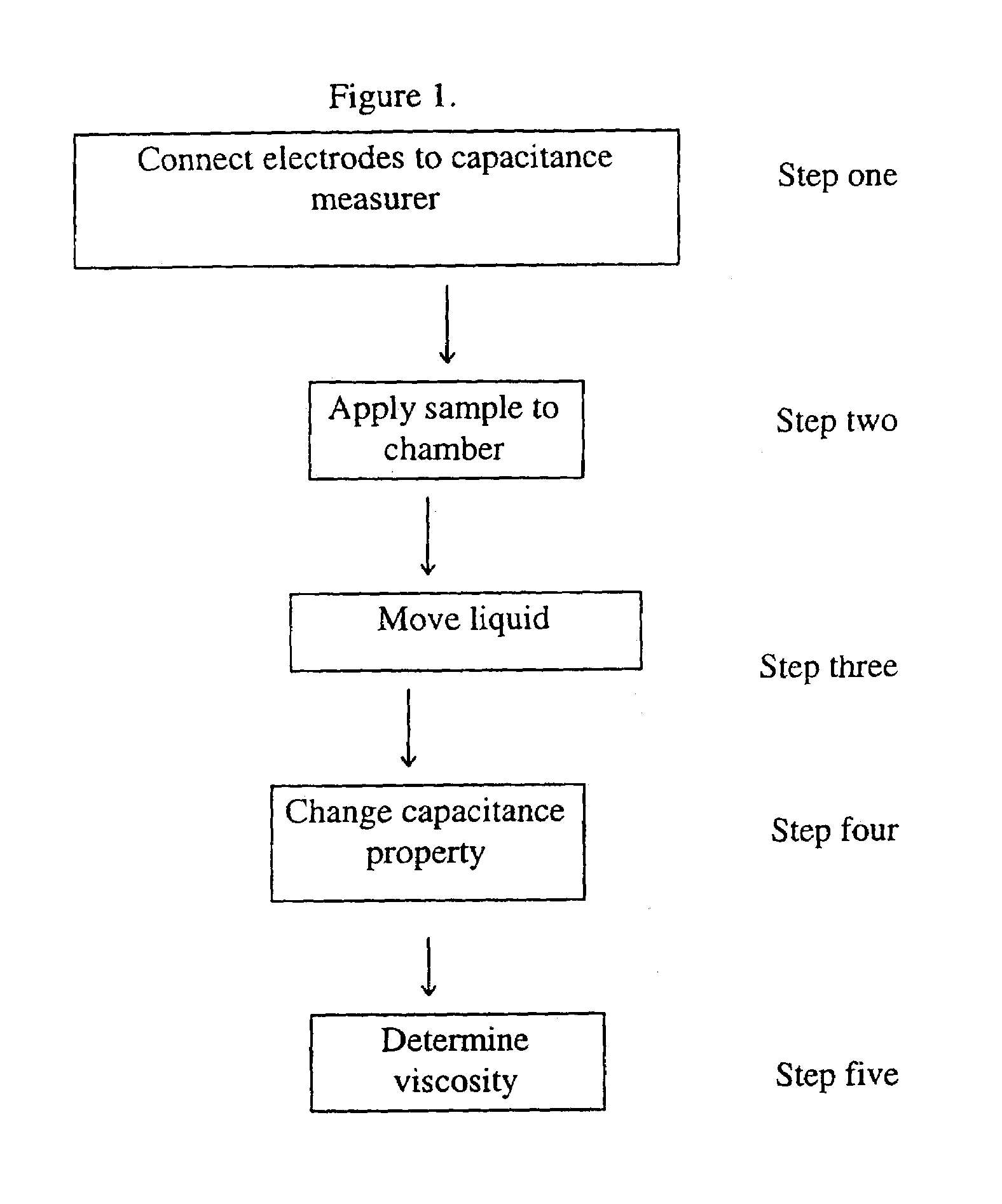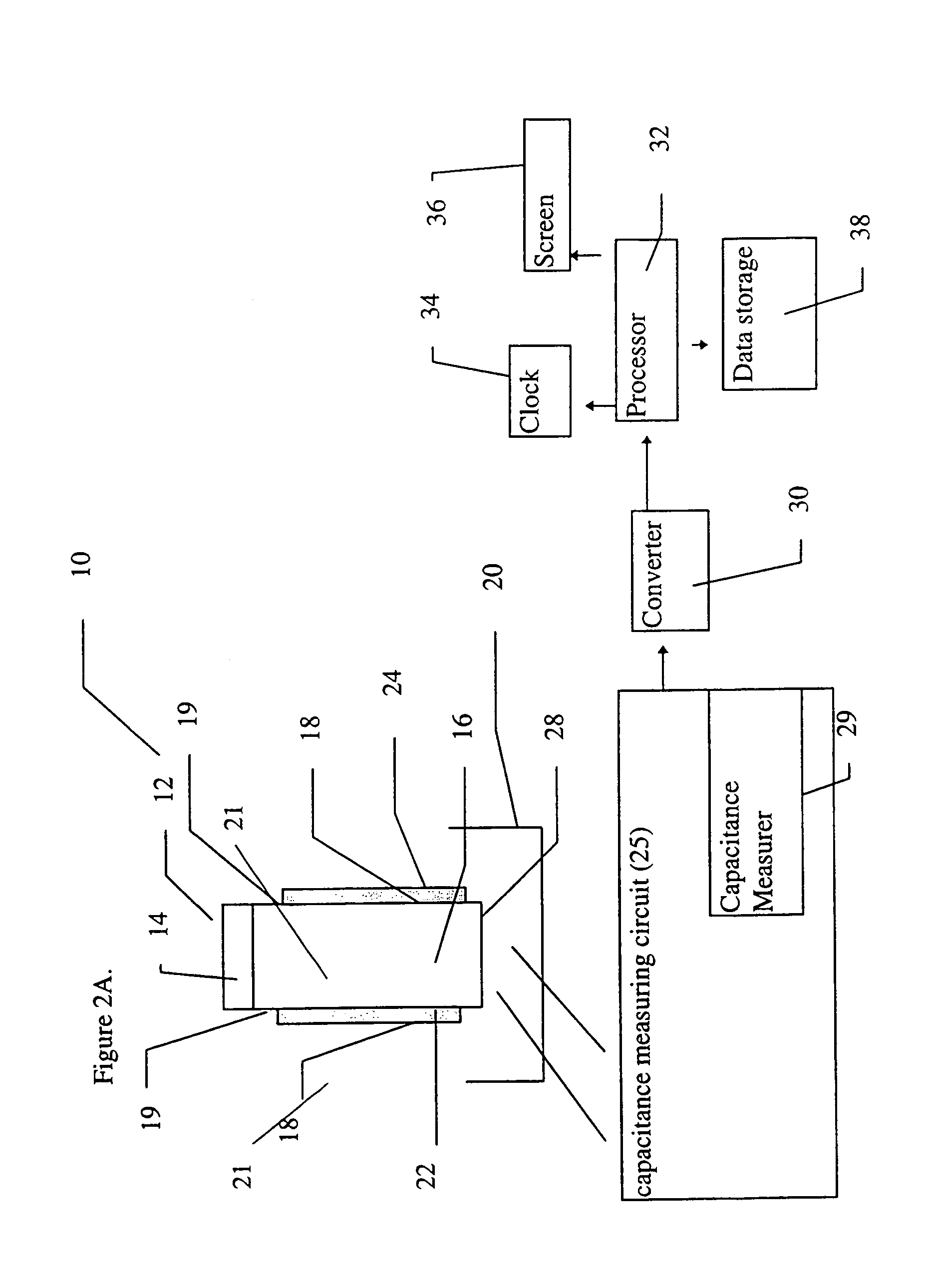Device for the determination of blood clotting by capacitance or resistance
a capacitance or resistance technology, applied in the direction of liquid/fluent solid measurement, level indicators by physical variable measurement, engine lubrication, etc., can solve the problem of excessive and dangerously prolonged clotting time in another patient, difficult adjustment of the amount of bioavailable drugs in the body, and complicated determination of dosing regimen
- Summary
- Abstract
- Description
- Claims
- Application Information
AI Technical Summary
Benefits of technology
Problems solved by technology
Method used
Image
Examples
example 1
Construction and Testing of a Clotting Time Device
[0126]The device, including the sensor, was constructed according to the first example of this embodiment of the device of the present invention, as shown in FIG. 5A. The sensor was constructed from a flat plastic base card, by building an approximately 1.5 mm wide and approximately 20 mm long capillary channel over the two conductive carbon tracks. The sides of the channel were built from double sided adhesive tape, about 200 microns deep. The channel was covered with a section of transparent polyester film. The arrangement was designed to permit a reference portion of a five microliter blood sample to travel along the entire length of the capillary channel, while a second portion of the same sample remains at the sample origin, thus preventing limitation of measurement by the sample size.
[0127]The electrodes were then attached to a standard voltage generating device, and the resulting current was then measured by a standard device ...
example 2
Construction and Testing of a Clotting Time Device with Dried Reagents
[0132]An exemplary device of the present invention was also constructed according to the first embodiment of the device of the present invention, as shown in FIG. 5A. In this case, however, coagulation reagents (Sigma Chemical Co) were dried in one area of the sensor. It should be noted that this device was also intended as an example for experimental testing only and was not meant to be limiting in any way.
[0133]FIG. 7A shows the variation of the current (micro-amperes) over time (seconds) for three different blood samples from patients undergoing anticoagulant therapy. These samples had different clotting times, which were measured as prothrombin time. Prothrombin time was determined both by the sensor, as shown in the graph, and with a standard reference method, employing an ACL1000 instrument. The clotting times obtained with the standard instrument are shown inside rectangles, attached to each of the current ...
example 3
Construction and Testing of a Clotting Time Device with Dried Reagents
[0137]An exemplary device of the present invention was also constructed according to the first embodiment of the device of the present invention, as shown in FIG. 5A. However, as further detailed below, certain modifications were made to the device. In particular, the carbon electrodes were subjected to a pretreatment, and a particular formulation of coagulation reagents was dried onto the sample area of the sensor of the present invention. It should be noted that this device was also intended as an example for experimental testing only and was not meant to be limiting in any way.
[0138]The preparation of this exemplary device according to the present invention was as follows. First, the carbon electrodes were cut and then pretreated by soaking in a buffer containing 0.1 M Na2CO3, 10 mg / ml BSA and 0.1% Tween-20 for 10 minutes at room temperature. Next, the electrodes were washed four times by dipping in distilled w...
PUM
 Login to View More
Login to View More Abstract
Description
Claims
Application Information
 Login to View More
Login to View More - R&D
- Intellectual Property
- Life Sciences
- Materials
- Tech Scout
- Unparalleled Data Quality
- Higher Quality Content
- 60% Fewer Hallucinations
Browse by: Latest US Patents, China's latest patents, Technical Efficacy Thesaurus, Application Domain, Technology Topic, Popular Technical Reports.
© 2025 PatSnap. All rights reserved.Legal|Privacy policy|Modern Slavery Act Transparency Statement|Sitemap|About US| Contact US: help@patsnap.com



